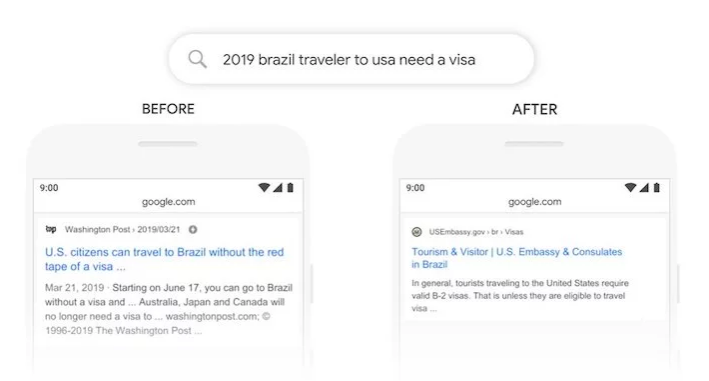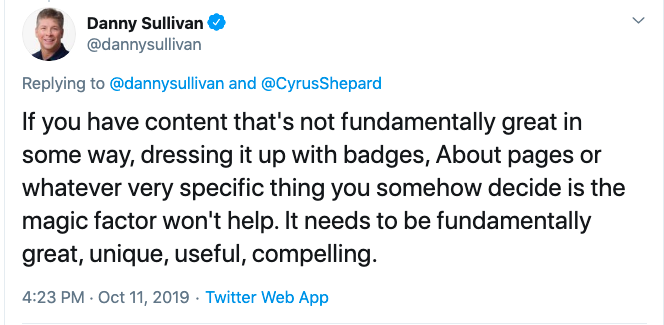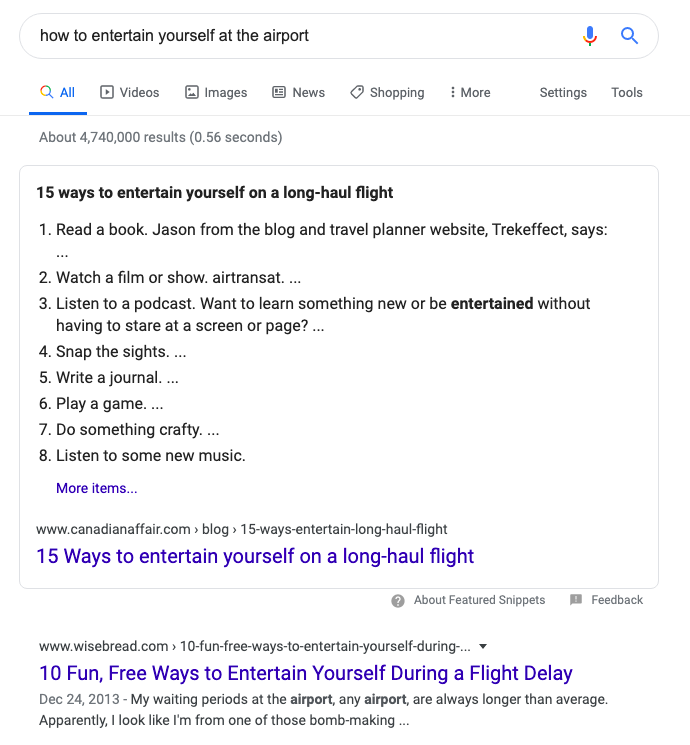In the realm of content marketing, we’ve come a long way since the days of keyword stuffing.
Unless you’re still keyword stuffing. Then consider this a rude awakening.
If living in Google’s RankBrain world post-2015 release has taught us anything, it’s that their algorithm isn’t just learning, it’s deep learning.
Natural language is the name of the game. And it continues to be in 2020 as we acclimate to their newest release, BERT.
Note: Are you looking for ways to increase lead generation on top of fantastic content, sign up for free Leadfeeder's 14-day trial and give it a try.
What’s new with Google’s latest algorithm update, BERT?
What’s the deal with Google’s latest algorithm update you ask? Well, think less unibrow and more prepositions.
Spell it out and BERT stands for Bidirectional Encoder Representations from Transformers. Super helpful, right?This is a fancy way of saying Google has put a lot of effort into better understanding natural language processing.And this makes sense. If Google’s ultimate goal is to serve its users the best possible results, their algorithm should be able to talk the talk — human talk.Natural language processing is basically linguistics for computers. It’s programming machines to process and analyze how we speak in an effort to improve upon interactions.BERT specifically builds on what RankBrain started. If you type a flight number into the search box, it’ll show you the status. Their autocomplete feature will finish your sentences.
But now, BERT is fine-tuning the process[ing].
Content marketing expert Neil Patel offers this example of BERT in action:

Notice the difference between the two. On the left, Google surfaced a result about those from the U.S. traveling to Brazil.
The After result is much more relevant to the search query “2019 brazil traveler to usa need a visa”. It recognizes the value of “to” in this instance and adjusts accordingly.
BERT is taking into account the context of a search in its entirety. This means an ever-improved experience for users and a continued emphasis on quality for content marketers.
Will BERT change content marketing?
As with any of Google’s algorithm changes, SEOs hop into action looking for tips and tricks on how to maintain their rankings.
How can we beat BERT?
We’re here to inform you that what follows next isn’t a play-by-play for how to outsmart the machine that is Google.
There are no technical whosits and whatsits to plug in for the sake of keeping your content ecosystem protected against a fall in SERP rankings.
As Google’ search liaison explains in this thread on Twitter, there’s no “magic factor” at play in Google’s ranking factors. Create quality content and you’ll go far. Period.

5 tips for creating content after BERT
All of the above has lead us to this moment — the pièce de résistance if you will.
And if you’ve been in the game long enough, you’re probably no stranger to the idea that quality is important in content creation.
What does quality mean relative to BERT, though? And how can you better account for it moving forward?
Here are five tips for creating content after BERT.
Pay attention to your traffic metrics
First things first. Before you toss out your content strategy for lead generation and build from scratch, take the time to dig into what’s happening on the backend.
BERT was released back in October of last year. The algorithm changes are still fresh but by now, you should be able to get a feel for how they’re impacting your website traffic.
Run some comparison reports by timeframe to help pinpoint what landing pages and content pieces are taking a hit.
How is the decrease in traffic impacting all other tracked KPIs?
Before you create any new content, take the time to fix what’s broken.
Type in keywords you had previously ranked for in search and see what appears in the top five results now.
How do those results differ from the content you have?
For some pieces, it may be as simple as phrasing. For others, you may now be seeing content of a higher caliber with variations in media and specificity.
Write for your user (as you always do)
Like we mentioned, there’s no need to start from scratch here. If you think of BERT as a refinement of RankBrain, then your content should aim for a similar kind of refinement.
What you actually write aside, your user should remain the focal point of your efforts.
There are no assets to optimize within your content landing pages. There’s no flip of a switch or quick fix.
The only way to combat content saturation and bring awareness to your brand is to create stuff people want to consume.
Informational content is the focus for BERT, so make sure the information you’re putting out into the web is hyper-relevant to what your audience cares about.
And if you’re reading this section unsure of who your target audience is, BERT is not the thing you should be worried about.
Stop focusing on word count
We’re not the first to say this and we certainly won’t be the last.
Stop focusing on word count.
Optimizing your content shouldn’t be about creating arbitrary guidelines for a team to follow.
If your writers simply think they have to meet a 2,000-word minimum every time they write with proper headers, sub-headers, and two-word keyword mentions, the mindset needs to shift.
There has to be an emphasis on, again, audience and research into the types of things they’re searching for. And more importantly, how you solve for their questions.
Instead of stuffing many keyword variations into a piece of content, bucket the keywords together based on how people ask questions relative to them.
Then pick popular phrases to naturally work into your content while addressing the answer to any particular question as quickly and thoughtfully as possible.
With featured snippets and the People Also Ask section, users expect to find what they need within a matter of seconds.
While there’s still a place for long-form content, don’t underestimate the value of shorter content, as well.
Amp up your long-tailed keywords game
To expand on the above, long-tail keywords are your friend.
If Google is learning how to deliver search results relative to how we speak, you should be writing content that reflects the same. Again, this all ties back to quality.
Short keyword phrases leave more room for ambiguity and can be interpreted in a number of different ways.
On top of that, it’s obvious to go after generic phrasing in SEO land. This is why so many people have already done it — and continue to do it.
The more specific your target, the smaller your competitive pool becomes.
You can get really niche with the content you create and deliver a quality product that few are otherwise taking the time to create.
Answer specific and follow-up questions better than the competition
The key phrase to focus on here is better than the competition. Yes, you know you have to lengthen those keywords and create good stuff.
But if you’re stuck on how to do that, look around you. Who’s ranking high for the types of searches you want to be ranking for?
Consider those SERPs as the benchmarks guiding your efforts forward.
For example, if a brand’s already written a blog on “how to entertain yourself at the airport”, is there a way to expand on what they’ve said? Or increase specificity?

Maybe you create content relative to one of the previously-mentioned points (e.g., play a game or read a book).
So instead of focusing on all entertaining things to do at the airport, you’re hyper-focused on just one thing — e.g. “entertaining games to play at the airport”.
Alternatively, you can reinvent how the content is presented through different types of media. Instead of just creating a blog, create a video, too.
Final thoughts: how to create content after BERT
Content marketing and SEO are constantly evolving to keep up with themselves.
As more and more marketers have realized the effectiveness of content and hopped on the bandwagon, Google’s had to account for volume and efficiency.
Especially since user expectations haven’t slowed relevant to the accessibility of information. People want to know things and they want to know them now.
And if you’re brand can stay in front of the questions your audience cares about most, they’ll want to know them now, not just from Google — but from you.
Take it from BERT that the best way to come out on top is to care enough not to hack the system. Build your content foundation on quality and the rest will fall into place.
Note: Are you looking for ways to increase lead generation on top of fantastic content, sign up for free Leadfeeder's 14-day trial and give it a try.
Now that you're here
Leadfeeder is a tool that shows you companies that visit your website. Leadfeeder generates new leads, offers insight on your customers and can help you increase your marketing ROI.
If you liked this blog post, you'll probably love Leadfeeder, too.
Sign up







